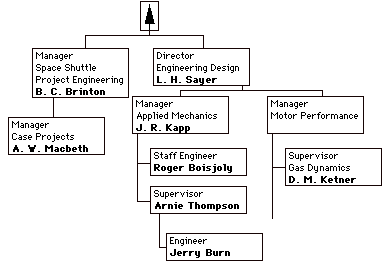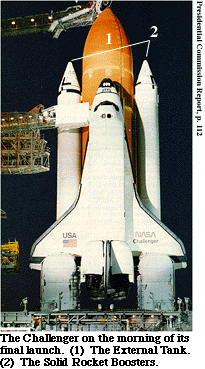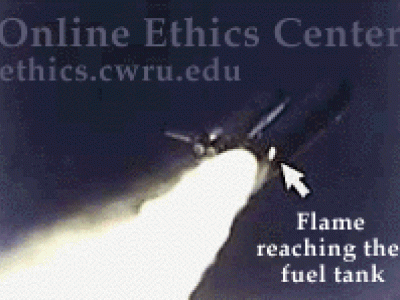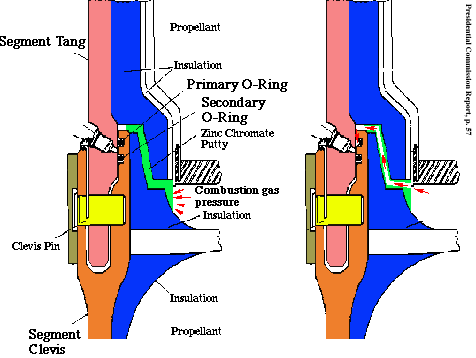Supporting Materials
This is a collection of supporting materials for the Challenger Explosion case.
II. Memo from A.R. Thompson on the Flight Seal
III. Memo from Roger Boisjoly on O-Righ Erosion
IV. Morton Thiokol Organizational Chart
V. Roger Boisjoly Curriculum Vitae
VI. What Went Wrong
I. A Major Malfunction
The story behind the Space Shuttle Challenger Disaster
YouTube version of video available here
A 3 part video program and instructional module containing a pedagogical documentary about organizational politics, ethics and decision making
- 150 plus page reading packet with 29 articles spanning from 1973 to 1990
- Written research case includes glossary, background materials and detailed summary chronology
- 150 pages of key excerpts from the Presidential Commission Report
- 25 figures and exhibits for overhead transparency masters
- Additional supplementary instructional materials
- Facilitator's guide using tried and tested suggestions for using materials with students and practitioners
For more information contact Dr. Mark Maier at mmaier@chapman.edu
II. Memo from A.R. Thompson on the Flight Seal
MORTON THIOKOL, INC
WASATCH DIVISION
Interoffice Memo
2871:FY86:141
22 August 1985
TO: S.R. Stein, Project Engineer
CC: J.R. Kapp, K.M. Sperry, B.G. Russell, R.V. Ebeling, H.H. McIntosh, R. M. Salita, D.M. Ketner
FROM: A.R. Thompson, Supervisor Structures Design
SUBJECT: SRM Flight Seal Recommendation
The O-ring seal problem has lately become acute. Solutions, both long and short term are being sought, in the mean time flights are continuing. It is my recommendation that a near term solution be incorporated for flights following STS-27 which is currently scheduled for 24 August 1985. The near term solution uses maximum possible shim thickness and a .292 +.005/-.003 inch dia O-ring. The results of these two changes are shown in Table 1. A great deal of effort will be required to incorporate these changes. However, as shown in the Table the O-ring squeeze is nearly doubled for the example (STS-27A). A best effort should be made to include a max shim kit and the .292 dia O-ring as soon as it is practical. Much of the initial blow-by during O-ring sealing is controlled by O-ring squeeze. Also more sacrificial O-ring material is available to protect the sealed portion of the O-ring. The added cros-sectional area of the .292 dia O-ring will help the resilience response by added pressure from the groove side wall.
Several long term solutions look good; but, several years are required to incorporate some of them. The simple short term measues should be taken to reduce flight risks.
A. R. Thompson
ART/jh
III. Memo from Roger Boisjoly on O-Righ Erosion
MORTON THIOKOL, INC
WASATCH DIVISION
Interoffice Memo
31 July 1985
2870:FY86:073
TO: R. K. Lund
Vice President, Engineering
CC: B. C. Brinton, A. J. McDonald, L. H. Sayer, J. R. Kapp
FROM: R. M. Boisjoly
Applied Mechanics - Ext. 3525
SUBJECT: SRM O-Ring Erosion/Potential Failure Criticality
This letter is written to insure that management is fully aware of the seriousness of the current O-ring erosion problem in the SRM joints from an engineering standpoint.
The mistakenly accepted position on the joint problem was to fly without fear of failure and to run a series of design evaluations which would ultimately lead to a solution or at least a significant reduction of the erosion problem. This position is now drastically changed as a result of the SRM 16A nozzle joint erosion which eroded a secondary O-ring with the primary O-ring never sealing.
If the same scenario should occur in a field joint (and it could), then it is a jump ball as to the success or failure of the joint because the secondary O-ring cannot respond to the clevis opening rate and may not be capable of pressurization. The result would be a catastrophe of the highest order - loss of human life.
An unofficial team (a memo defining the team and its purpose was never published) with leader was formed on 19 July 1985 and was tasked with solving the problem for both the short and long term. This unofficial team is essentially nonexistent at this time. In my opinion, the team must be officially given the responsibility and the authority to execute the work that needs to be done on a non-interference basis (full time assignment until completed.)
It is my honest and very real fear that if we do not take immediate action to dedicate a team to solve the problem with the field joint having the number one priority, then we stand in jeopardy of losing a flight along with all the launch pad facilities.
R. M. Boisjoly
Concurred by:
J. R. Kapp, Manager
Applied Mechanics
IV. Morton Thiokol Organizational Chart
- Bob Eberling
- Bob Eberling, one of the engineers who agreed with Boisjoly and Thompson and supported their efforts to address the O-ring problem. Eberling, however, did not confront management the night of the telecon, has said, in January of 1996 on Sixty Minutes, that he feels he should have done more.
- Jerry Mason
- General Manager of Morton Thiokol whom Roger Boisjoly describes as pressing for the launch at the January 27, 1986 teleconference with NASA officials.
- Joe Kilminster
- Vice-President of Space Booster Program at Morton Thiokol, who first recommended against launch in light of the engineering concerns raised in the teleconference with NASA on January 27, 1986.
- Bob Lund
- Bob Lund, who was the Vice-President of Engineering, is the person to whom Roger Boisjoly sent his famous memo the summer before the fatal flight of the Challenger, the memo in which he stated his concern that failure to address the problem would mean an explosion of a shuttle flight. Lund had often listened to Boisjoly in the past and it was to Lund that Boisjoly and his colleagues took their case for postponing the flight in view of the record cold predicted. They convinced him of the danger and secured his decision to recommend against flying. However, in the teleconference, under pressure from NASA and from Morton Thiokol management, he reversed himself and voted to fly.
- Al MacDonald
- Al MacDonald was a manager who was concerned about the joints and seals. Roger Boisjoly had sent him a copy of his 7/31/85 memo to Vice-President of Engineering, Bob Lund. MacDonald was at NASA's Kennedy Center for the telecon with Mulloy and Reinarz. At the launch MacDonald found out that Reinarz had not reported the MTI engineer's concerns to other NASA officials. MacDonald alerted the Presidential Commission to the existence of the telecon.
- Boyd Brinton
- Manager of Space Shuttle at Marshall Space Flight Center, who remained quiet during teleconference. He was one of the people to whom Roger Boisjoly sent a copy of his 7/31/85 memo to Vice-President of Engineering, Bob Lund.
- L.H. Sayer
- L.H. Sayer, Director of Engineering Design, was present but silent during the teleconference the night before the Challenger flight. He was one of the people to whom Roger Boisjoly sent a copy of his 7/31/85 memo to Vice-President of Engineering, Bob Lund.
- Jack Kapp
- Jack Kapp, Manager of Applied Mechanics, was Roger Boisjoly's immediate supervisor. Notice that when Roger Boisjoly wrote his memo directly to the Vice-President of Engineering, he showed the memo to Kapp so as not to undercup Kapp in going over his head. Kapp chose to countersign that memo. However, Kapp was silent in the telecon the night before the flight.
- Roger Boisjoly
- Morton Thiokol Engineer who in 1988 received the AAAS Award for Scientific Freedom and Responsibility for his efforts to avert the Challenger disaster. Roger Boisjoly had been elected Mayor of his town, Willard, Utah, in 1982.
- D.M. Ketner
- D.M. Ketner, Supervisor, Gas Dynamics was the person who headed the seal task force that was formed after Roger Boisjoly's memo to the Vice-President of Engineering on 7/31/85. The team had five full-time members, including Boisjoly.
- Arnie Thompson
- Engineer who worked with Roger Boisjoly and who was active in rasing concerns about the joints and the seals. He wrote his own memo stating his concerns to management on 8/22/85 and was active in raising the issue of the effect of cold temperatures on the resiliency of the O-ring seals at the teleconference with NASA the night before the flight. He also gave testimony to the Presidential Commission that investigated the disaster.
V. Roger Boisjoly Curriculum Vitae
Born April 25,1938 in Lowell. Massachusetts. Received a B.S.G.E. (Mechanical Engineering) degree in 1960 from the University of Massachusetts at Lowell (formerly Lowell Technological Institute). Also enrolled in Continuing Education Courses while in industry and subsequently, seminars in Forensic Engineering Practices and Investigative Methods. Employed 27 years in the United States Aerospace Industry in the primary disciplines of Mechanical Design and Structural Analysis. Pursued a career agenda to go beyond the normal job description of "Designer Only" or "Analysts Only" by participating in a Full Circle of engineering & related disciplines. This career agenda supplied me with many unique experience tools providing a natural transition into Forensic Engineering and Lecturing about Professionalism, Organizational Behavior and Ethics. My final assignment in industry was a Technical Troubleshooter on the Space Shuttle Solid Rocket Boosters. As a principal engineer in the telecon meeting with NASA managers, I recommended and defended the original no-launch decision, then vigorously opposed the four Thiokol senior managers who subsequently seized control of the meeting and voted to launch Challenger despite my continual objection. My testimony was vital to exposing the truth about the decision to launch and the organizational misbehavior at both Morton Thiokol and NASA.
WORK HISTORY AND ACCOMPLISHMENTS
Lecturer on Ethics, Professionalism and Organizational Behavior
Ethics and Professionalism Lectures and Seminars, 1/87 to Present
Lectures on Ethics, Professionalism and Organizational Behavior given at many leading Universities, Technical Societies, Corporations and Civic Organizations in the USA, Canada, Mexico, Norway and Argentina. A wide variety of lectures have been given and are available to fulfill a broad spectrum of needs, while keeping a focus on ethics, professionalism and organizational behavior. In the beginning, the two most requested presentations were "The Space Shuttle Challenger Disaster - a paradigm for changing workplace/career ethics" which focuses on the Challenger pre-launch decision process using a timeline of major technical problem discoveries on the booster joints. Also presented is management behavior at Morton Thiokol and NASA prior to and subsequent to launch. "Commencement of a Professional Career" which focuses on: The Task of Selecting an Entry Level Position; Getting Settled in the Position Selected; How to Get Recognition for a High Quantity of Quality Work Output; How to Spot Defined Organizational Trouble & What to Do About It; Examples from Boisjoly's career, showing the importance of developing Ethical Professional Behavior.
Additional lectures having heightened recent appeal along with the previous two are: "The Challenger Disaster & Commencement of a Professional Career" which combines elements from each talk to create the best opportunity for lessons learned to avoid career problems that can often result in career or organizational unethical behavior, if lessons learned are ignored. "What do Engineers Do? - the anatomy of making a widget" explains the inner workings of the engineering profession by using the steps required to take a widget (product) from an idea/concept to a finished product. Some show & tell items are used to demonstrate, explain, & simplify some basic engineering and manufacturing principles used to produce a high volume of identical widgets. "The Overemphasis on Excessive Profits at the expense of Professionalism, Business Ethics & Safe Quality Products" discusses case examples from Boisjoly's Forensic Engineering practice from commercial & consumer products to the stealing of trade secrets and unethical professional behavior. Several defective products are highlighted with video clips and sketches showing the obvious defects and the relatively minor cost effective fixes that were ignored by the manufacturers, even after litigation exposed the defects. "Professional Life After Being Branded a Whistleblower" addresses the recovery details from a destroyed career and how a typical blackball by industry was defeated by creation of a self-employed career. Several vivid examples of corporate mistreatment of a Whistleblower are given to demonstrate the uphill battle necessary to survive the event. "The Importance of Leadership, Teamwork & Information Flow and Ethical Behavior" discusses the 30+ year decline of business ethics in the USA. The consequences are demonstrated by using a brief summary of the Challenger disaster launch decision process. The presentation concludes with recommendations and rationale for what constitutes a productive organization and why teamwork, information flow and ethics are so important for long-term success.
Presentations can be customized for content focus and length from a 1/2 hour Luncheon talk to a 2 hr. main talk plus Q/A. Also available are partial day or multiple day workshops or seminars. Over 550 lectures given since January 1987.
HONORS AND AWARDS
- 1982 CERTIFICATE AND AMERICAN FLAG that was flown on the 2nd Space Shuttle Flight - for my significant contributions
- 1982 Elected to the position of MAYOR of Willard, Utah
- 1986 CERTIFICATE OF APPRECIATION from NASA for my support given to the Investigation of the Challenger Disaster.
- 1987 COMMENCEMENT ADDRESS to the College of Engineering, University of Massachusetts at Lowell
- 1987 DISTINGUISHED ALUMNI AWARD from the University of Massachusetts at Lowell
- 1987 PRESIDENTIAL AWARD from the National Space Society for Professional Integrity and Personal Courage
- 1988 SCIENTIFIC FREEDOM AND RESPONSIBILITY AWARD from the American Association for the Advancement of Science
- 1988 CITATION OF HONOR AWARD from The Institute of Electrical and Electronics Engineers
- 1989 COMMENCEMENT ADDRESS to the College of Engineering, University of Toledo
- 1990 ENGINEERING ETHICS AWARD from the National Academy of Forensic Engineers
- 1990 CAVALLO PRIZE from the Cavallo Foundation for Moral Courage in Business and Government
- 1991 COMMENCEMENT ADDRESS to the graduating class, GateWay Community College
- 1994 UTAH ENGINEER OF THE YEAR from Utah Engineers Council and Utah Society of Professional Engineers
PROFESSIONAL ASSOCIATIONS
- Fellow, American Association for the Advancement of Science (AAAS)
- Former Member, Utah Society of Professional Engineers (USPE) & Arizona Society of Professional Engineers (ASPE)
- Member, Association for Practical & Professional Ethics (APPE)
- Former Senior Member, National Academy of Forensic Engineers (NAFE), retired from practice in 1997
- Former Senior Member, Institute of Electrical and Electronics Engineers (IEEE), retired from practice in 1997
- Former Member, National Society of Professional Engineers (NSPE), retired from practice in 1997
REGISTRATION
Registered Professional Engineer in Arizona, Florida (retired) and Utah, by National Examinations
PUBLICATIONS
- Text of talk given at MIT on January 7, 1987, BOOKS AND RELIGION, March/April 1987, Duke University Divinity School
- NASA, MORTON THIOKOL MUST RETHINK RISK, The Scientist, September 21, 1987
- ETHICAL DECISIONS, MORTON THIOKOL AND THE SPACE SHUTTLE CHALLENGER DISASTER, ASME paper 87 WA/TS-4, presented at ASME winter meeting December 15, 1987, Boston, Massachusetts
- ETHICS - TODAYS ACHILLES' HEEL IN THE PROFESSIONS, ASCE paper, 1990 Forum on Education and Development
- ETHICS: ONE OF TODAY'S BUSINESS DILEMMAS IN THE USA, Careers and the Engineer, 1990 Spring Edition
- WHERE'S THE TRUE VOICE OF THE EE ?, Electronic Engineering Times, March 25, 1991
- ENGINEERING PROFESSIONALISM/ETHICS: NECESSITY OR LUXURY?, VPI Ethics & the Professions Symposium 9/92
- PROFESSIONAL INTEGRITY & ACCOUNTABILITY, Accounting Horizons, American Accounting Association, March 1993
- LOAD PATH ANALYSIS OF EXTENSION LADDER FAILURES, NAFE Journal Paper, June, 1995
- ETHICS- THE #1 INGREDIENT FOR L.T. SUCCESS OF ORGANIZATIONS, Cronista Management Newspaper, July 1995
- THE SPACE SHUTTLE CHALLENGER DISASTER: A Paradigm for Changing Workplace/Career Ethics, APPE annual mtg. 2/96
- PROFESSIONAL LIFE AFTER BEING BRANDED A WHISTLEBLOWER: Exposure to bottom-line Profit vs. Corporate Business Ethics, APPE annual meeting, February 1997
- WHAT DO ENGINEERS DO? - The anatomy of making a widget, APPE annual meeting, February 1999
- EMPLOYMENT SEARCH WITH A CONSCIENCE, Careers and the Engineer, 1999 Spring Edition
Media Experience, a Sample Listing
| Date(s) | Media Experience |
|---|---|
| February 14, 19, 25, May 2, 9, 1986 | Testimony to the Presidential Commission investigating the Challenger Disaster |
| June 17, 18, 1986 | Testimony to the House of Representatives Committee on Science and Technology investigating the Challenger Disaster |
| February 10, 1987 | ABC TV, GOOD MORNING AMERICA, Washington, D.C. |
| February 18, 1987 | NATIONAL PUBLIC RADIO (NPR), interview with Howard Berkes |
| June 24, August 4, 1987 | PBS TV, MacNeil/ Lehrer NEWSHOUR, interview with Elizabeth Brackett |
| February 22, 1988 | LIFE MAGAZINE, interview with Tony Chiu |
| February 23, 1988 | ABC RADIO NETWORK, Owen Spann Show, New York City |
| February 23, 1988 | NBC TV, TODAY SHOW, New York City |
| July 7, 1988 | SIDNEY AUSTRALIA, Channel 9 TV, interview with Peter Wilkinson |
| September 9, 1988 | NEWSWEEK MAGAZINE, interview with Harry Hurt III |
| June 2, 1989 | PBS TV, BILL MOYER'S, THE PUBLIC MIND -- The Truth About Lies episode |
| August 10, 1990 | NBC TV, STORY BEHIND THE STORY, interviews and reenactments |
| January 10, 1991 | NBC TV, TOM BROKAW EVENING NEWS, interview with Robert Bazelle |
| August 1, 1991 | PUBLIC TESTIMONY to the U.S. House of Representatives Committee on Science, Space and Technology, Subcomittee on Investigations and Oversight |
| January 21, 1996 | CBS TV, 60 MINUTES, interview with Lesley Stahl |
| January 25, 1996 | CBS TV, DAN RATHER EVENING NEWS, interview with Scott Pelley |
| January 26, 1996 | NPR, TALK OF THE NATION SCIENCE FRIDAY, interview with Ira Flatow |
| January 26, 1996 | WRKO RADIO BOSTON, interview with hosts Claprood and Whitley |
| January 27, 1996 | MUNICH GERMANY and DUTCH TV, interview with John Elliott |
| January 27, 1996 | DISCOVERY CHANNEL TV TORONTO CANADA, interview |
| January 29, 1996 | WFLA RADIO TAMPA, interview with hosts Jack Harris and Ted Webb |
| September 19, 1997 | STONE CITY FILMS. Challenger Documentary TV Film, London, England |
| April 24, 2000 | OPRAH WINFREY SHOW. People Who Stand For Something, ABC TV |
| January, 2001 | MSNBC 15th ANNIVERSARY PROGRAM. Interview on The Challenger. |
| January 28, 2001 | DISCOVERY CHANNEL. 15th Anniversary. Interview on The Challenger. |
| April 24, 2002 | INSIDE EDITION, stove tipping interview/demo for anti-tipping redesigned door hinge |
VI. What Went Wrong
Why was Roger Boisjoly so concerned about O-Rings? These seemingly insignificant pieces of rubber played a critical role in the joints between segments of a solid rocket boster (SRB ).
The two SRBs attached to a space shuttle orbiter provided eighty percent of the thrust necessary to propel the shuttle into space. About two minutes after a normal launch, the SRBs would detach and parachute back to the ground to be reused in subsequent missions. Several cylindrical segments make up the 149.1-foot- (45.4-meter-) tall SRB. Each joint between these segments contains two O-rings, positioned concentric with the SRB. The O-rings must be in perfect condition to prevent hot gasses from leaking through the joints of the SRB.
THE CHALLENGER: WHAT WENT WRONG
Within a second of the launch of Challenger on January 28, 1986, the first signs of failure of a joint in the right SRB were visible. Puffs of black smoke, whose color suggested that 5800-degree gases were eroding the O-rings, spewed out of that joint three to four times each second. At the end of the first minute, a small but steady flame was evident.
Atmospheric and aerodynamic conditions directed the flame plume onto the surface of the External Tank, used to supply liquid hydrogen and liquid oxygen fuel to the shuttle's engines during the launch. The flame eventually breached the tank, and a massive amount of hydrogen and oxygen burst into flame. At 73 seconds, a nearly explosive burn of the hydrogen and oxygen quickly resulted and claimed the Challenger with its crew.
Above: A Solid Rocket Booster and its segments. The aft field joint (arrow) failed in the Challenger's right SRB.
A Solid Rocket Motor Joint. Its parts are colorized in this diagram for clarity. In pink is the tang, which joins the clevis, colored orange. 177 huge steel pins (yellow) hold the joint in place. The O-rings shield the joint from 5800-degree gases inside the booster.
On the left scenario, hot gases (red arrows) are shielded from the joint by the zinc-chromate putty. On the right, immense pressure creates a blowhole in the putty, allowing the O-rings to move into the positions needed to seal the joint as the gap between tang and clevis expands. Through the blowhole, gases penetrate and wear away the O-rings.
Boisjoly had noticed that O-rings eroded, to an extent, in this fashion previously. NASA and Thiokol, however, decided that, since the O-rings were not completely eroded, there was minimal risk. Boisjoly's concern was that the low launch temperature would cause the O-rings to contract and further compromise their sealing value.
This diagram is a cross section. In actuality, the joint itself, tang, clevis, and O-rings have the circular shape of the SRB.
Sources: Report to the President by the Presidential Commission on the Space Shuttle Challenger Accident.
Photographs adapted from pages 112, 52, and 57 of the Presidential Commission Report.






